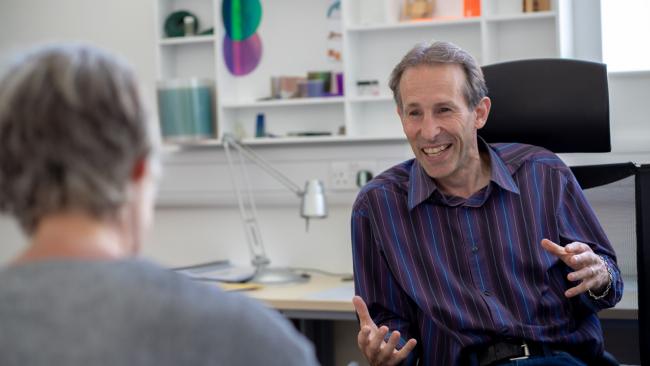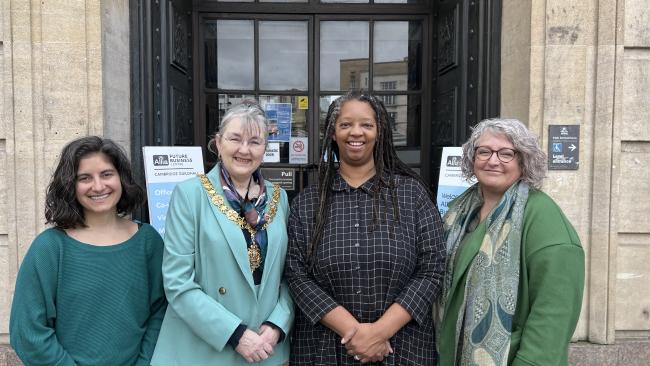
The nanoscientist, his love for colour and clocks, and the dancing atoms
Imagine wallpaper that can change colour or a toilet that monitors dopamine levels. College Fellow Professor Jeremy Baumberg and colleagues are developing materials made from atoms that bend, flex and gyrate. Nature, he says, is our greatest teacher.
Never again will I wear a tie. That’s what I promised myself when I left industry to return to academia. At formal events in Cambridge I wear a bolo. They’re the stringy braided leather ties worn by cowboys and I have quite a selection. No-one’s quite sure whether they meet the formal dress code or not, so I get away with it.
I spent eight years in industry. I worked for two years for IBM in the USA and for six years for Hitachi in the UK and Japan. That gave me experience in two very different environments. I returned to Cambridge ten years ago and have been able to form valuable partnerships with industry here.
My job is all about people. As Director of the NanoPhotonics Centre I head a team of around 50 researchers from all over the world. Our work is all about light, surfaces structured on the smallest nanoscales and novel materials. I also lead another university-wide initiative that brings almost 1,000 people together from 10 different disciplines — from physics to biotechnologies.
I get my energy from the minds around me. That’s one of the wonderful things about Cambridge. I believe in diversity and in creative anarchy. The most exciting things happen when you push boundaries and collaborate with people outside your own field. Much of my most productive time is spent in forming teams.
But I also have a hermit side. Sometimes I long to spend a day without any interruptions concentrating on science. I’m fascinated by changing colours and surfaces. One of the materials we’re working on could become a coating for buildings that would respond to temperature differences and keep the building cool or warm.
An intelligent toilet is one of many current projects. Its surface will be programmed to pick up information from urine. Just think: a huge number of people are on anti-depressant drugs yet we have no way of measuring daily dopamine levels. Data gathered could track variations and inform individual treatment regimes.
We understand only a fraction of the world around us. The proteins that human life depends on are essentially tiny machines. We haven’t even scraped the surface in understanding how they work or in building new ones from scratch. We know a bit about molecules and atoms but really not much when you look at them one by one.
How nature produces surfaces and colour effects is phenomenal. Humans are clunky in comparison. By studying and mimicking nature we can produce new materials that will revolutionise the ways we live. We need the freedom in research to see how far we can get.
I’m most definitely a no-clutter person. You won’t see any books in my office. Of course, I do read books. In fact, I love The London Review of Books because it opens up new worlds. But to work, I need space and order.
I recently spent a sabbatical year in Spain. I was working at institutes in San Sebastian, so really the Basque Country. When we got there, I pointed to the mountains behind the city and said to my kids: “Before we go home, we’ll have climbed all these.” They said: “No we won’t.” But we did — and now they ask me which mountain we’re climbing next.
In the mornings I wrote a book. The Secret Life of Science burrows into the way that science works as an ecosystem. I explore how scientists choose what they work on, why research journals fight to be top dog, how large research fields break into fragments, and why globalisation might not be such a good thing. As a society, we pay for scientific research and it’s intriguing to see how it really works. I’m trying to understand more about scientists’ habits.
Science is intensely competitive. But is this always a good thing? If people are constantly stressed, they don’t get the time and space they need for reflection. In my book I argue that this hypercompetitive environment encourages clusters and stifles diversity. We need science to be resilient and wide ranging.
I was a child who took things apart. I’d put them back together but never in the way they’d started off. My parents bought me an early computer — a Sinclair ZX81 — and I programmed it to do maze games, fitted into its tiny memory. Through this laborious process, I became mathematically adept and began to grasp the concepts behind electronics.
My father was a geneticist at Leeds University. At home he didn’t talk about his work but he took us walking in the Yorkshire Dales and to classical concerts. I learnt the piano and, when I was 18, I got a music scholarship to Jesus College, Cambridge, where I did Natural Sciences. The course was perfect for someone interested in every aspect of science. I came alive.
The piano taught me the importance of focus. In order to get better, you need to practise. The piano appealed because much of the repertoire is for solo pieces. As a boy I was quite shy. Luckily I had a marvellously gentle piano teacher. I could happily spend eight hours of the day practising Rachmaninov and other romantic pianists. I performed several piano concertos. I still long to play the Rhapsody on a Theme of Paganini.
Art is an important part of human endeavour. Art reflects your ideas back at you and also takes you into different dimensions. I’m especially interested in kinetic art and large-scale installations.
My research involves tiny things. You can’t see them with the naked eye or even with the most powerful imaging technology. To be a good scientist you need intuition as well as a solid grasp of your subject. We’re working on a new generation of materials made from atoms that bend, flex and dance.
At home I build big mechanical clocks. One of my favourite objects is the ball bearing clock at the British Museum in London. At the moment I’m making a slow balance wheel clock from scratch using wood, Perspex and magnets. I find it wonderful to be creating with my hands and having my whole mind absorbed by a set of problems.
It’s important to be humble. By and large, scientists are not lonely heroes. We make progress through having common objectives, working as teams and valuing each other. We need to communicate what we’re doing and get more people involved. That’s why I’m taking part in the Royal Society Summer Exhibition this week.
Jeremy Baumberg is a College Fellow, a Professor of Nanoscience and Director of Nano Doctoral Training Centre. The opinions expressed are those of the author. This article was originally published by the University of Cambridge on mention.com.





